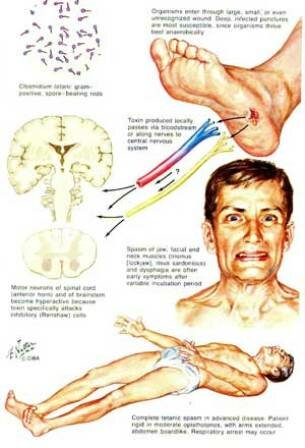One of these following facts about tetanus should make you more aware of what kind of condition it is. Tetanus is a medical condition characterized by a prolonged contraction of skeletal muscle fibers. The primary symptoms are caused by tetanospasmin, a neurotoxin produced by the Gram-positive, rod-shpaed, obligate anaerobic bacterium Clostridium tetani. Infection generally occurs through wound contamination and often involves a cut or deep puncture wound. As the infection progresses, muscle spasms develop in the jaw (thus the name lockjaw) and elsewhere in the body. Furthermore, to get to know more about this infection, here are some other facts about tetanus you should be more aware of.
Facts about tetanus 1: Signs and Symptoms
Tetanus often begins with mild spasms in the jaw muscles—also known as lockjaw or trismus. The spasms can also affect the chest, neck, back, abdominal muscles, and buttocks. Back muscle spasms often cause arching, called opisthotonos. Sometimes the spasms affect muscles that help with breathing, which can lead to breathing problems.
Facts about tetanus 2: Mortality Rates
Mortality rates reported vary from 48% to 73%. In recent years,approximately 11%of reported tetanus cases have been fatal. The highest mortality rates are in unvaccinated people, people over 60 years of age or newborns.
Facts about tetanus 3: Incubation Period
The incubation period of tetanus may be up to several months, but is usually about eight days. In general, the further the injury site is from the central nervous system, the longer the incubation period. The shorter the incubation period, the more severe the symptoms.
Facts about tetanus 4: Generalized Tetanus
The generalized form usually presents with a descending pattern. The first sign is trismus, or lockjaw, and the facial spasms called risus sardonicus,, followed by stiffness of the neck, difficulty in swallowing, and rigidity of pectoral and calf muscles. Other symptoms include elevated temperature, sweating, elevated blood pressure, and episodic rapid heart rate.
Facts about tetanus 5: Neonatal Tetanus
Neonatal tetanus is a form of generalized tetanus that occurs in newborns, usually those born to mothers who themselves have not been vaccinated. If the mother has been vaccinated against tetanus, the infants acquire passive immunity and are thus protected. It usually occurs through infection of the unhealed umbilical stump, particularly when the stump is cut with a non-sterile instrument.
Facts about tetanus 6: Local Tetanus
This is an uncommon form of the disease, in which patients have persistent contraction of muscles in the same anatomic area as the injury. The contractions may persist for many weeks before gradually subsiding. Local tetanus is generally milder; only about 1% of cases are fatal, but it may precede the onset of generalized tetanus.
Facts about tetanus 7: Cause
Tetanus is often associated with rust, especially rusty nails. Objects that accumulate rust are often found outdoors, or in places that harbour anaerobic bacteria, but the rust itself does not cause tetanus nor does it contain more C. tetani bacteria. The rough surface of rusty metal merely provides a prime habitat for C. tetani endospores to reside in, and the nail affords a means to puncture skin and deliver endospores deep within the body at the site of the wound.
Facts about tetanus 8: Diagnosis
There are currently no blood tests for diagnosing tetanus. The diagnosis is based on the presentation of tetanus symptoms and does not depend upon isolation of the bacterium, which is recovered from the wound in only 30% of cases and can be isolated from patients without tetanus.
Facts about tetanus 9: Prevention
Tetanus can be prevented by vaccination with tetanus toxoid. The CDC recommends that adults receive a booster vaccine every ten years, and standard care practice in many places is to give the booster to any patient with a puncture wound who is uncertain of when he or she was last vaccinated, or if he or she has had fewer than three lifetime doses of the vaccine.
Facts about tetanus 10: Treatment
In order to survive a tetanus infection, the maintenance of an airway and proper nutrition are required. An intake of 3,500 to 4,000 calories, and at least 150 g of protein per day, is often given in liquid form through a tube directly into the stomach, or through a drip into a vein.
Hope you would find those tetanus facts really interesting, useful and helpful for your additional information to prevent the infection.








 www.PortlandPayday.Loans
www.PortlandPayday.Loans